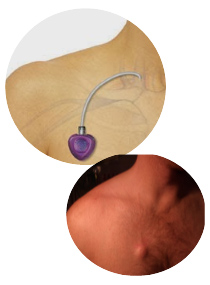Port Insertion Fact Sheet
What is a portacath port insertion?
A portacath is an implanted venous access device via port insertion for patients who need frequent or continuous administration of medications or other infusions. The port sits in the chest wall (similar to a pacemaker) and may remain “insitu” for many months.
Why do I need this procedure?
Your Doctor has asked for this port insertion procedure to be performed because you require the following;
- Chemotherapy
- Alternative infusion therapy
- Your port can be used for taking blood and CT scans involving injection of contrast.
- Once your treatment is complete and you no longer require the port it can be removed.

What should I expect?
- The procedure can take between 30-60 mins.
- You will be able to sit up immediately after the procedure.
- You may be required to take some time off work – please let the nurses know so they can organise a medical certificate for you. An attendance certificate can be provided for your carer.
- Please make sure you have someone to pick you up after your procedure. You procedure will be cancelled if you don’t have an escort. Please contact MIVIR as soon as possible if this cannot be arranged.
- If you have been unwell in the week leading up to your procedure date, please contact MIVIR as your procedure may need to be rebooked.
On the day of your Procedure
You will need to present to the Day Procedure Unit on the day of your appointment – your admission time will be sent to you with your appointment time. This will allow the nurses time to complete your admission paperwork and any other tests that may be required such as blood tests or pre-medication.
You will be required to fast for 4 hours before you procedure – this means no food or fluids. You may take any regular medication with a small sip of water. Please continue to take your blood pressure medication. Please bring a list of your medications with you.
Please contact MIVIR if you are taking medication for the following conditions;
- Diabetes,
- Stroke,
- Heart Conditions such as a Heart Attack or Atrial Fibrillation.
Further Information
The following organisation also provides reliable health information:
Portacath – Sydney Interventional Radiology
Author: Dr John Vrazas
